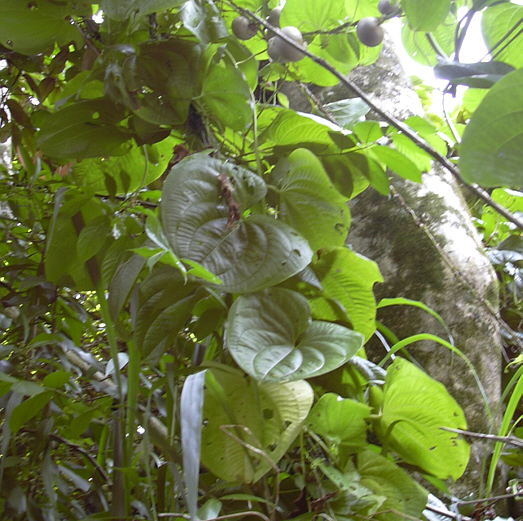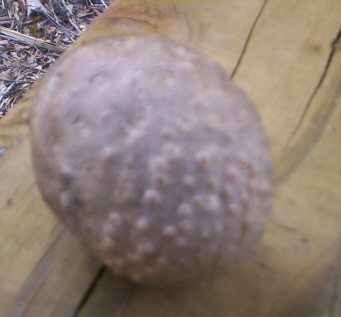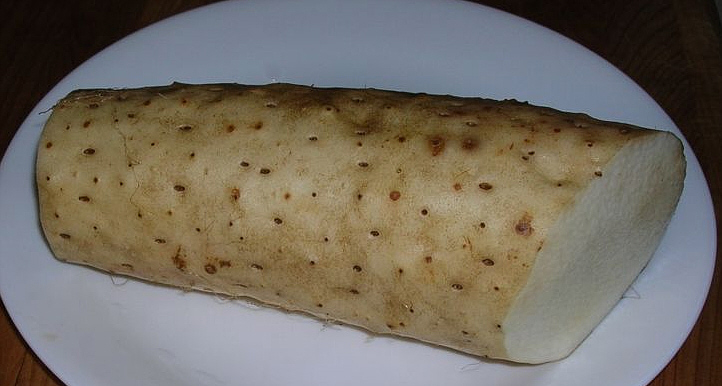

Zitierweise / cite as:
Carakasaṃhitā: Ausgewählte Texte aus der Carakasaṃhitā / übersetzt und erläutert von Alois Payer <1944 - >. -- Anhang A: Pflanzenbeschreibungen. -- Dioscorea L. sp. -- Fassung vom 2007-07-27. -- URL: http://www.payer.de/ayurveda/pflanzen/dioscorea.htm
Erstmals publiziert: 2007-07-27
Überarbeitungen:
Anlass: Lehrveranstaltung SS 2007
©opyright: Dieser Text steht der Allgemeinheit zur Verfügung. Eine Verwertung in Publikationen, die über übliche Zitate hinausgeht, bedarf der ausdrücklichen Genehmigung des Verfassers
Dieser Text ist Teil der Abteilung Sanskrit von Tüpfli's Global Village Library
Falls Sie die diakritischen Zeichen nicht dargestellt bekommen, installieren Sie eine Schrift mit Diakritika wie z.B. Tahoma.
Verwendete und zitierte Werke siehe: http://www.payer.de/ayurveda/caraka0001.htm

Abb.: Dioscorea bulbifera L. = Yams
[Bildquelle: Wikipedia]

Abb.: Dioscorea bulbifera L. = Yams
[Bildquelle: Wikipedia]

Abb.: Dioscorea oppositifolia L. = Yams
[Bildquelle: Wikipedia]
Drury:
"Dioscorea bulbifera (Linn.) N. O. Dioscoreaceae. Katu-katsjil, Mal.
Description.—Leaves alternate deeply cordate, acuminate, 7-nerved; the exterior nerves 2-cleft; transverse veins reticulated; stem bulbiferous; male spikes fascicled.—Wight Icon. t. 878.—Rheede, vii. t. 36.------Both Concans.
Economic Uses.—The Dioscoreas are climbing and sarmcntaceous plants. The roots are large, tuberous, and very rich in nutritious starch. The flowers and roots are eaten by the poorer classes: the latter are very bitter, but after undergoing the process of being covered over with ashes and steeped in cold water, they become eatable.—(J. -Graham.) Several species yielding yams are eatable. Among the principal may be mentioned the D. aculeata (Linn.) The tubers are about 2 lb. or more in weight. They are dug up in the forests in the cold season, and sold in the bazaars. They are known as the (Goa potato. The D. globosa (Roxb.) is much cultivated as yielding the best kind of yam, much esteemed both by Europeans and natives. The D. triphylla (Linn.), not eatable, for the tubers are dreadfully nauseous and intensely bitter even after being boiled. They are put into toddy to render it more potent, as they have intoxicating properties. A few slices are sufficient for the purpose.—J. Graham.
Dioscorea pentaphylla (Linn.) Do.
Nureni kelangu, Mal. Kanta-aloo, Beng.
Description.—Tubers oblong; stems herbaceous, twining, prickly; leaves digitate, downy; male flowers panicled, greenish white, fragrant; female ones spiked.—Roxb. Fl. Ind. iii. 806.— Wight Icon. t. 8U—Rheede, vii. t. 34, 35.-------Concans.
Economic Uses.—A common species in jungles on low hills, but never cultivated, so far as I have seen, says Dr Wight, which is remarkable, as I have always found the natives dig the tubers whenever they had an opportunity to dress and eat them. The male flowers are sold in the bazaars and eaten as greens, and are said to be wholesome. There are several other kinds of edible yams, among which may be mentioned the D. fasciculata (Roxb.), which is cultivated largely in the vicinity of Calcutta, where it is known as the soosnialoo; a starch is also made from the tubers. Another kind is the D. purpurea (Roxb.), known as the Pondicherry sweet potato, which is an excellent kind of yam, but only found in a cultivated state.— (Roxb. J. Grah.) The roots of the D. deltoidea are used in Cashmere for washing the pashm or silk for shawls and woollen cloths.— Powells Punj. Prod."
[Quelle: Drury, Heber <1819 - 1872>: The useful plants of India : with notices of their chief value in commerce, medicine, and the arts. -- 2d ed. with additions and corrections. London : Allen, 1873. -- xvi, 512 p. ; 22 cm. -- s.v.]